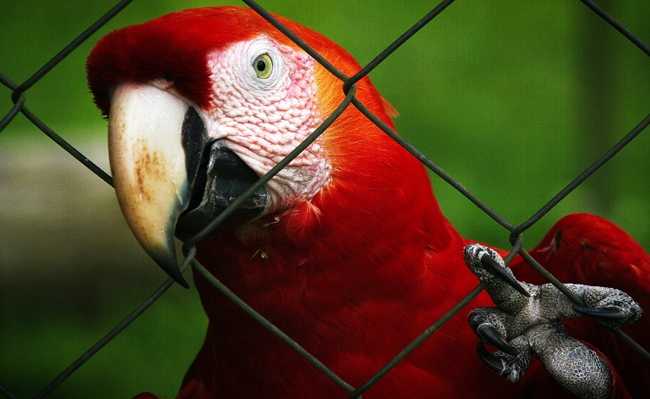Wildlife trafficking: what it is and how to report
Trafficking in wild animals contributes to the extinction of species and can cause imbalance in ecosystems

Paolo candelo image on Unsplash
Wild animal trafficking is the third largest illegal activity in the world, second only to drug and arms trafficking. It consists of removing wild animals from their natural habitats and illegally trading them. In addition to causing harm to animals, this practice is considered a great risk to biodiversity and the ecological balance of ecosystems.
As it is home to the greatest biodiversity on the planet, Brazil is one of the main targets for wild animal trafficking. Another factor that contributes to this practice in the country is the lack of inspection and severe punishment. According to studies, wild animal trafficking moves around 10 to 20 billion dollars around the world, and our country participates with 15% of this amount.
Types of wild animal trafficking
There are four types of wildlife trafficking. Are they:
- For private collectors: in this type of trafficking, endangered animals are more in demand;
- For scientific purposes: phenomenon known as biopiracy, this type of trafficking uses wild animals for scientific purposes;
- For sale in pet shops: this type of traffic is driven by demand, where commercial establishments encourage the illegal purchase and sale of wild animals;
- For the production of by-products: in this type of trafficking, animals are used to manufacture ornaments and crafts, and feathers, leather, skin and tusks are illegally traded.
Causes of wild animal trafficking
In general, the causes of wild animal trafficking are often attributed to the socioeconomic characteristics of the country and its regions, especially in nations with high biodiversity and social inequality. Thus, in places with high unemployment rates and low levels of formal education, activities related to wildlife trafficking can be very profitable, including providing additional income to the families involved.
Wildlife trafficking has become a massive global industry, attracting criminal groups driven especially by low risks, high profits and low punishments. Furthermore, due to its high profitability, trafficking has also financed new illegal fronts and transnational crimes, generating economic losses and political destabilization in countries where endangered species cannot be easily protected. Far from being more of a conservation or animal welfare issue, the illegal trafficking and trade of wild animals should be seen as a matter of national and global security.
Wild animal trafficking in Brazil
Trafficking in wild animals in Brazil causes the annual removal of approximately 38 million specimens from forests and forests, according to data from IBAMA. The high rate of removal of animals from their habitats puts an increasing number of species at risk of extinction. Most of the animals captured in Brazil are traded in the Brazilian territory, with the most affected regions being the North, Northeast and Midwest.
Once captured, the animals are subjected to various aggressive practices during transport to consumer centers. In addition, they are stored in shared cages, with no space to move around, and often end up being malnourished and dying.
Because they are traded at higher prices, endangered animals are the main target of traffickers. The Hyacinth Macaw is an example of a more smuggled species, especially among collectors. However, animals that have low commercial value are also victims of illegal trade, especially birds, turtles and marmosets.
The wild animals most sought after by the traffic are birds, primates and snakes:
- Blue Arara;
- Ocelot;
- Lear's Macaw;
- Red Macaw;
- Red-tailed Parrot;
- Golden Lion tamarin;
- Boa;
- Toucan;
- Rattlesnake;
Consequences of wild animal trafficking
The constant removal of animals from the same species can lead to local or total extinctions, in addition to affecting other species with which it is related. The reduction in animal populations of a species is also a favorable factor for extinction because it facilitates the crossing between relatives, which impoverishes genetic diversity and makes it difficult for animals to adapt to environmental changes.
Animal trafficking contributes to ecological imbalance, causing changes in the food chain of the habitats from which they were removed. Furthermore, wildlife trafficking considerably reduces the biodiversity of a given environment.
Other environmental consequences generated by wildlife trafficking include the introduction of exotic species, the spread of diseases and the interruption of ecosystem processes and ecological services such as pollination, seed dispersal, population control of other animals, and, in medium and long term, the extinction of overexploited species. Among these issues, the problems arising from biological invasions stand out, which are a major environmental concern and a primary threat to global biodiversity.
Pets can escape or be abandoned and, back to free life, can settle in regions outside their original distribution, causing numerous ecological problems, such as the spread of pathogens, genetic loss through hybridization and introgression, interspecific competition and extinction of species, in addition to numerous impacts on ecosystem processes. Thus, identifying potential invasive species before their introduction and analyzing the ecological implications of possible escapes of captive animals is a current and fundamental issue to prevent the impacts of invasive alien species even before they become established.
It is noteworthy that the illegal trade in animals is closely involved with the spread of zoonoses (diseases transmitted by animals to humans). More than 180 zoonoses have already been identified, the following should be highlighted:
- Tuberculosis: common transmission by primates;
- Rabies: the most common cases involve transmission by dogs and cats, but contamination can occur through contact with marmosets (heavily trafficked), howler monkeys, capuchin monkeys, spider monkeys and bats. The rabies virus is transmitted by bites or when a wound on the skin comes into contact with the saliva of a sick animal;
- Leptospirosis: transmitted by mammals;
- Psittacosis: transmitted by birds, including parrots and macaws (heavily trafficked);
- Salmonellosis: perhaps the most widespread zoonosis in the world. It is widely transmitted by birds, mammals and reptiles, such as tortoises and iguanas;
How to report wild animal trafficking?
In Brazil, the control and inspection of wild animals is carried out by IBAMA and the Environmental Military Police. Upon identifying an irregular situation related to wild animals, it is possible to file a complaint - which can be anonymous or not. It can be done in the following ways:
- In case of suspicion of animal trafficking, contact IBAMA's Green Line (0800 61 8080), provide the information and request assistance on the actions that can be taken;
- If you witness wildlife trafficking, record as much information as possible, such as the location of the action, license plates of the vehicles involved, characteristics of the people who are buying and selling, which animals, among other information;
- If you see any wild animal lost or at risk, contact the competent bodies so that the rescue and capture are done correctly. It is important never to try to rescue the animal alone.










